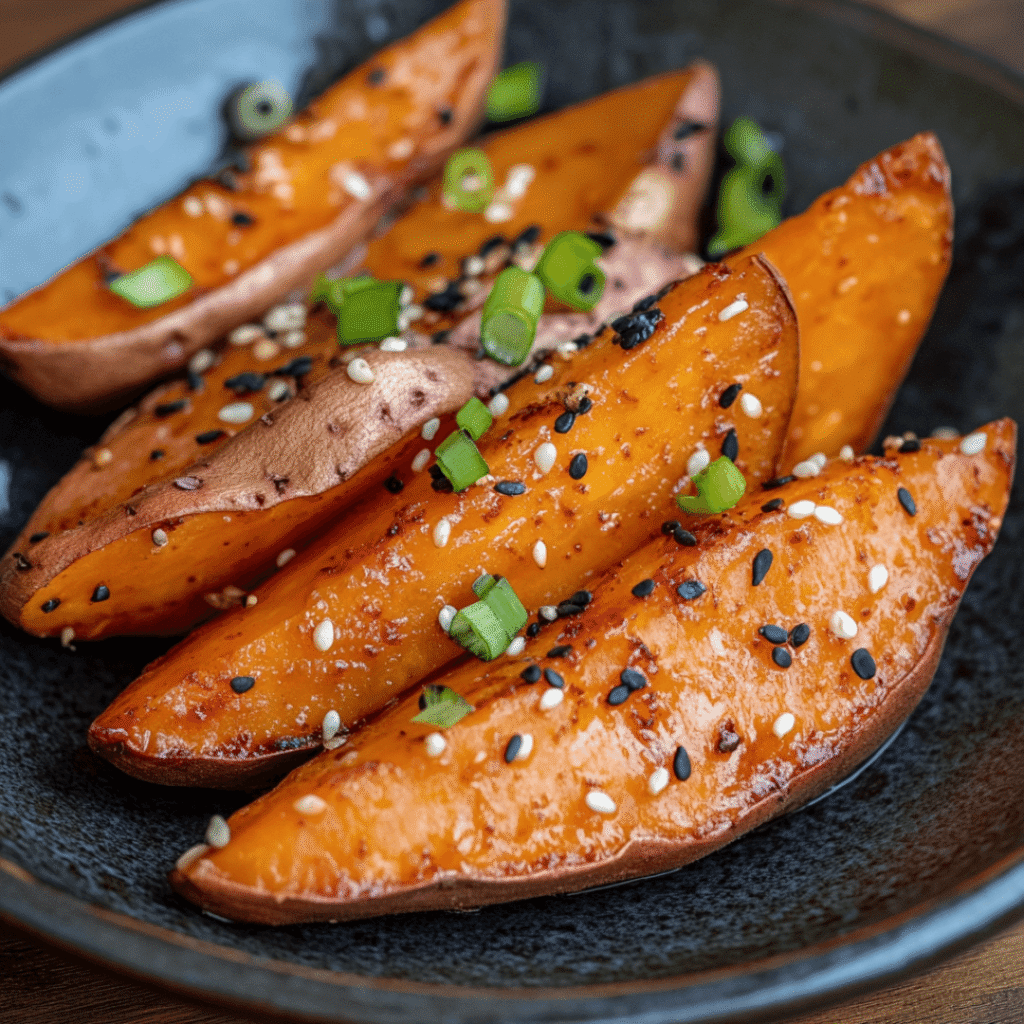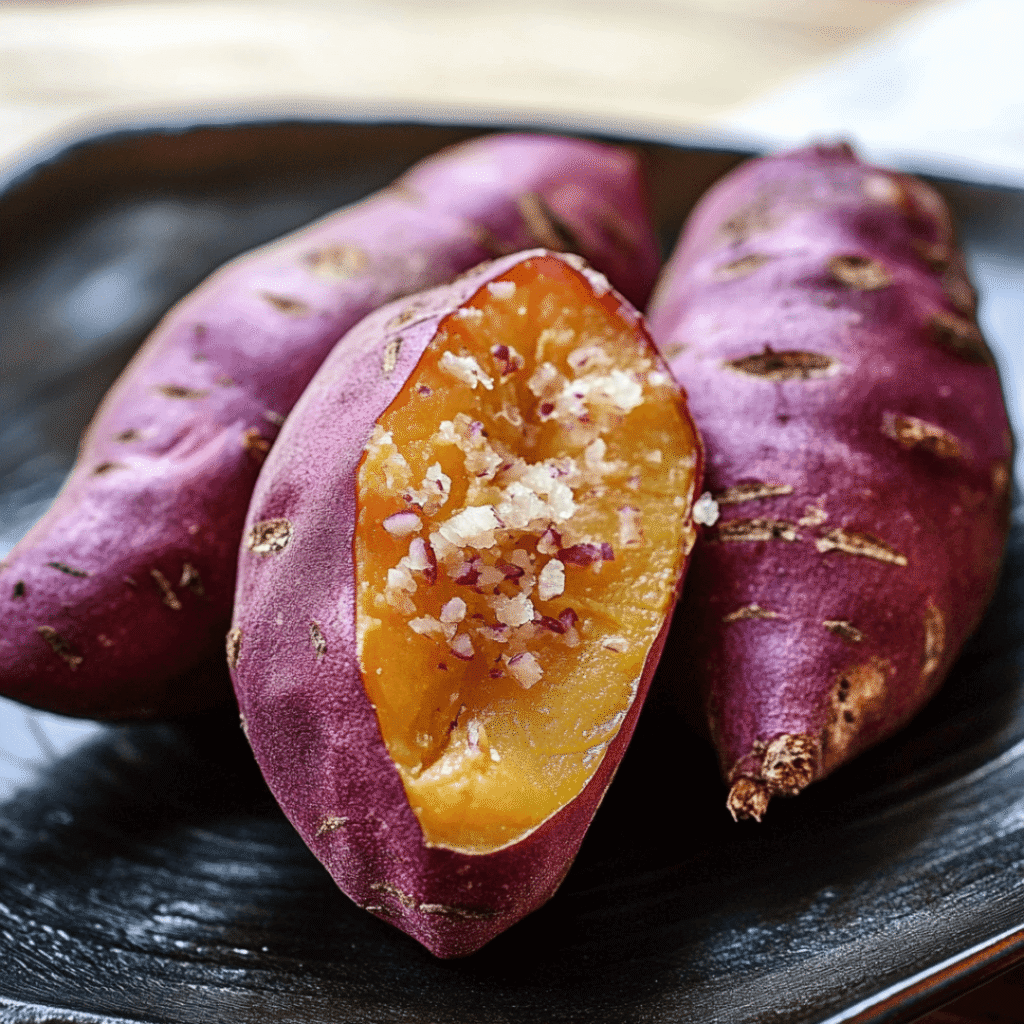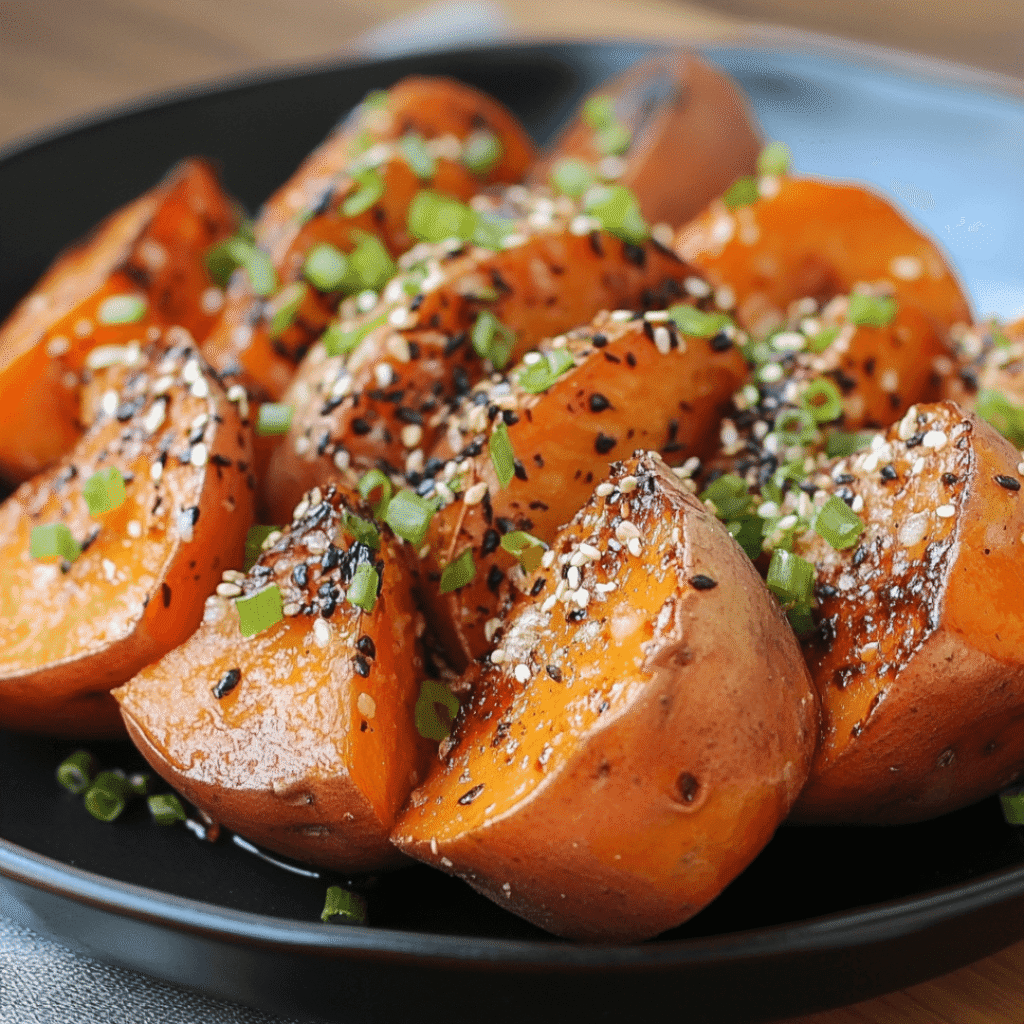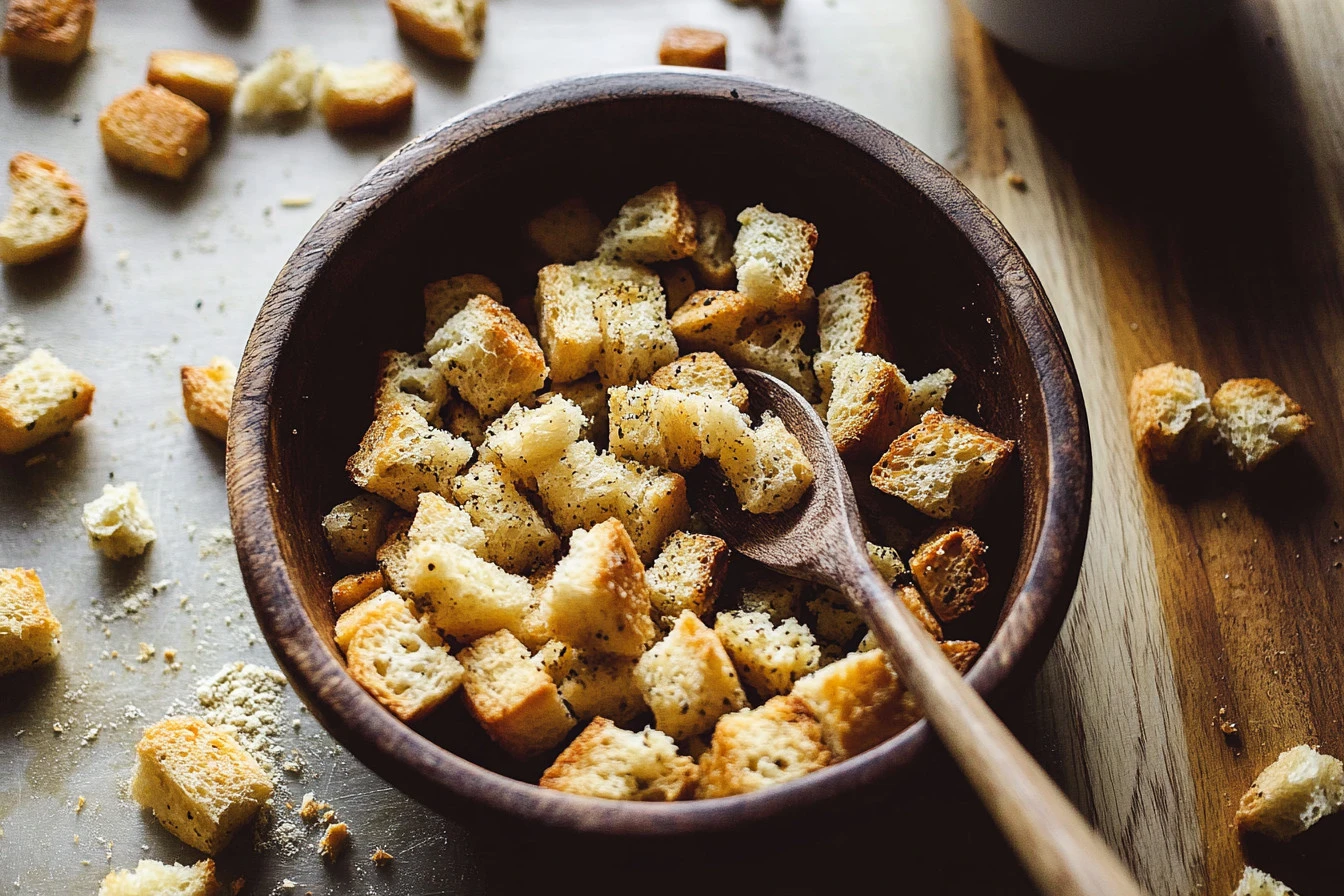
A Sweet Memory in Every Bite
Some recipes are more than just food — they’re stories, memories, and family traditions passed down like precious heirlooms. For me, roasted Japanese sweet potatoes carry the warmth of my grandmother’s kitchen, the smell of autumn leaves, and the comfort of quiet Sunday evenings.
In her old countryside home, my nonna would roast satsumaimo over wood ashes, letting their sugars slowly caramelize. The skin would crisp and the golden interior would become as soft as pudding. She would serve them simply, sometimes with a pinch of sea salt or a drizzle of honey if she was feeling fancy. No complicated techniques, just patience and love.
That’s the beauty of Japanese sweet potatoes — they don’t need much to be delicious. Their creamy, nutty sweetness intensifies with heat, transforming this humble root into a delicacy. Whether you enjoy them as a snack, side dish, or light meal, this recipe will show you how to unlock their full flavor potential using just your oven.
Why You’ll Love This Recipe
Roasted Japanese sweet potatoes are more than tasty — they’re nourishing, satisfying, and incredibly easy to prepare. Here’s why they deserve a regular spot on your table:
🍠 1. Naturally Sweet & Buttery
Unlike orange-fleshed varieties, Japanese sweet potatoes are firmer and starchier, with a natural sweetness that deepens as they roast. Their chestnut-like flavor and golden, creamy flesh make every bite comforting.
💪 2. Super Nutritious
High in fiber, complex carbs, and loaded with vitamins A, B6, and C, these potatoes are not only a great energy source, but also support gut health and immunity. They’re also low on the glycemic index, making them a smart choice for blood sugar stability.
🌿 3. Simple & Minimalist
Just three basic ingredients — sweet potatoes, oil, and salt — and an oven. That’s all you need to create this dish. It’s cooking at its most elemental.
🌦️ 4. Perfect for Any Season
These are especially cozy in colder months, but with lighter toppings, they work beautifully year-round. They’re as suitable for meal prep in summer as they are for holiday sides in winter.
🍽️ 5. Versatile & Adaptable
From savory bowls to sweet snacks, this recipe is a canvas. Dress it up with tahini and herbs or turn it into dessert with cinnamon and maple. One ingredient, endless options.
What Are Japanese Sweet Potatoes?
Known in Japan as satsumaimo, these sweet potatoes have reddish-purple skin and pale yellow or cream-colored flesh that deepens to gold as they cook. They’re distinct from orange-fleshed varieties commonly found in the U.S., with a firmer texture and sweeter, nuttier taste.
In Japanese cuisine, satsumaimo are often eaten roasted as street food, made into tempura, or blended into sweets like daigaku imo (candied sweet potatoes) or even baked into breads and cakes. Their popularity spans centuries — even samurai ate them!
Ingredients
🔖 Basic (Serves 4)
- 4 medium Japanese sweet potatoes, scrubbed well
- 2 tablespoons olive oil (or melted coconut oil)
- 1 teaspoon sea salt
- Freshly ground black pepper, to taste (optional)
🍯 Optional Garnishes & Flavors
- Toasted sesame seeds
- Drizzle of tahini or miso butter
- Maple syrup & ground cinnamon for dessert
- A sprinkle of chili flakes or shichimi togarashi
These additions help you explore new flavor profiles while keeping the focus on the potato’s natural sweetness.

✅ How to Select the Best Japanese Sweet Potatoes
When shopping for satsumaimo, keep the following tips in mind:
- Look for Firmness: Choose sweet potatoes that feel heavy for their size and are free from soft spots or cracks. They should feel firm and dense when you squeeze them gently.
- Even Skin Color: The skin should be a deep reddish-purple, smooth, and free from blemishes or wrinkling. Slight scarring is normal but avoid any with mold or green patches.
- Medium Size is Best: Medium-sized potatoes (around 5–7 inches long) tend to roast more evenly than very large ones and have a better balance of skin and flesh. Smaller ones also caramelize more quickly.
- Uniform Shape: If you’re cooking multiple potatoes together, try to choose ones that are similar in size and shape so they cook at the same rate.
🧺 How to Store Japanese Sweet Potatoes
Proper storage ensures your sweet potatoes stay fresh and flavorful for weeks:
- Cool, Dark, and Dry: Store in a basket or box in a cool (55–60°F or 13–15°C), well-ventilated place. A pantry or cellar is ideal — not the fridge!
- Avoid the Refrigerator: Cold temperatures can affect the texture and convert the starches into sugars too quickly, making them gritty or overly sweet.
- Keep Away from Moisture: Never wash them before storage — moisture leads to mold and spoilage.
- Use Within 2–3 Weeks: For peak flavor and texture, try to use your sweet potatoes within 14–21 days of purchase.
🌱 Can You Grow Them at Home?
Yes! If you live in a warm climate, Japanese sweet potatoes can be grown from slips (sprouted vines from the potato). Just make sure they get plenty of sun and well-drained soil — and be patient. They take about 90–120 days to mature.
Kitchen Tools Needed
You don’t need a lot to pull this off, but here are the basics:
- Baking sheet or roasting pan
- Parchment paper or aluminum foil
- Sharp knife and cutting board
- Mixing bowl (for seasoning)
- Tongs or spatula
- Oven mitts
Optional:
- A wire rack (placed on the baking sheet) helps achieve crispier skins by allowing airflow underneath.
Step-by-Step Instructions
🔥 1. Preheat the Oven
Set your oven to 400°F (200°C). This temperature ensures the potato’s sugars caramelize without burning.
🧼 2. Clean & Dry
Scrub the sweet potatoes well — especially since we’re leaving the skins on. Pat them dry with a clean towel.
🔪 3. Prepare the Potatoes
- Whole Roasted: Prick them a few times with a fork to allow steam to escape.
- Halved: Slice lengthwise for faster roasting and more crispy surface area.
🫒 4. Season
In a bowl, toss potatoes with olive oil and sea salt until evenly coated. If you’re roasting halves, place them cut-side down for better browning.
⏱️ 5. Roast
Place on a parchment-lined sheet and roast:
- Halved: 35–45 minutes
- Whole: 50–60 minutes
They’re done when a knife slides in easily and the skin has wrinkled or puffed slightly.
🔁 6. Optional Flip
Flip once halfway through for even browning, especially if using a baking sheet without a wire rack.
🧂 7. Serve Warm
Let them rest 5–10 minutes before serving — they’ll continue to soften and their sweetness intensifies.
Serving Suggestions
Japanese sweet potatoes are a blank canvas. Here are some inspired ways to enjoy them:
🥢 Classic Japanese Style
- Serve plain with green tea.
- Pair with miso soup and steamed rice.
🥗 Nourish Bowls
- With quinoa, kale, chickpeas, tahini dressing.
- Add grilled tofu or salmon for protein.
🍯 Sweet Dessert Style
- Slice open, drizzle with maple syrup, sprinkle cinnamon and top with crushed pecans or walnuts.
🍛 Savory Main
- Add kimchi, a soft-boiled egg, scallions, and sesame oil.
- Use miso-glazed slices in a grain bowl.
Storage & Reheating Tips
These reheat beautifully, so don’t hesitate to make a big batch.
Refrigerate
Store in an airtight container for up to 4 days.
Freeze
Wrap in foil or parchment and store in a freezer bag for up to 2 months.
Reheat
- Oven: 375°F for 10–15 minutes
- Air fryer: 350°F for 5–7 minutes
- Microwave: 1–2 minutes on high
Recipe Variations
🌶️ Savory Variants
- Miso-Glazed: Whisk white miso with mirin and maple syrup.
- Garlic Herb: Mix in minced garlic and rosemary with olive oil.
- Crispy Spicy: Add paprika and chili powder for a smoky edge.
🍬 Sweet Variants
- Dessert Boats: Scoop out the center, mix with cinnamon, maple, and coconut milk, then return to the skin.
- Sweet Bean Topping: Add a spoonful of sweet red bean paste (anko) and a dusting of kinako (roasted soybean flour).
🌍 Global Fusion
- Greek-style: Top with olives, tomatoes, and feta.
- Korean-inspired: Gochujang mayo, kimchi, and scallions.
- Tex-Mex: Add black beans, avocado, and corn salsa.
Frequently Asked Questions (FAQ)
❓ Can I eat the skin?
Yes! It crisps up when roasted and contains fiber and nutrients.
❓ What’s the best way to roast whole ones?
Prick with a fork and roast at 400°F for about 50–60 minutes.
❓ How do Japanese sweet potatoes taste different?
They’re sweeter, denser, and less watery than orange varieties.
❓ Can I cook them in an air fryer?
Absolutely. Slice into wedges and roast at 375°F for 20–25 minutes.
❓ Are they good for weight loss?
Yes — high fiber and low glycemic index help regulate appetite and blood sugar.

Final Thoughts
Few ingredients deliver as much comfort and satisfaction as a perfectly roasted Japanese sweet potato. Whether you’re reconnecting with tradition or just looking for a simple, nourishing recipe, this dish has a way of bringing joy to your table.
Cook it once and it’ll likely become a staple — a go-to for chilly nights, lazy Sundays, or meal prep days. And if you ever need a reminder that food can be both humble and deeply delicious, just roast a satsumaimo and let its sweet scent fill your kitchen.
💬 What’s Your Favorite Way to Enjoy Japanese Sweet Potatoes?
Let me know in the comments below — and don’t forget to share this recipe with someone who loves cozy, healthy cooking as much as you do.




